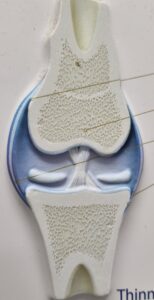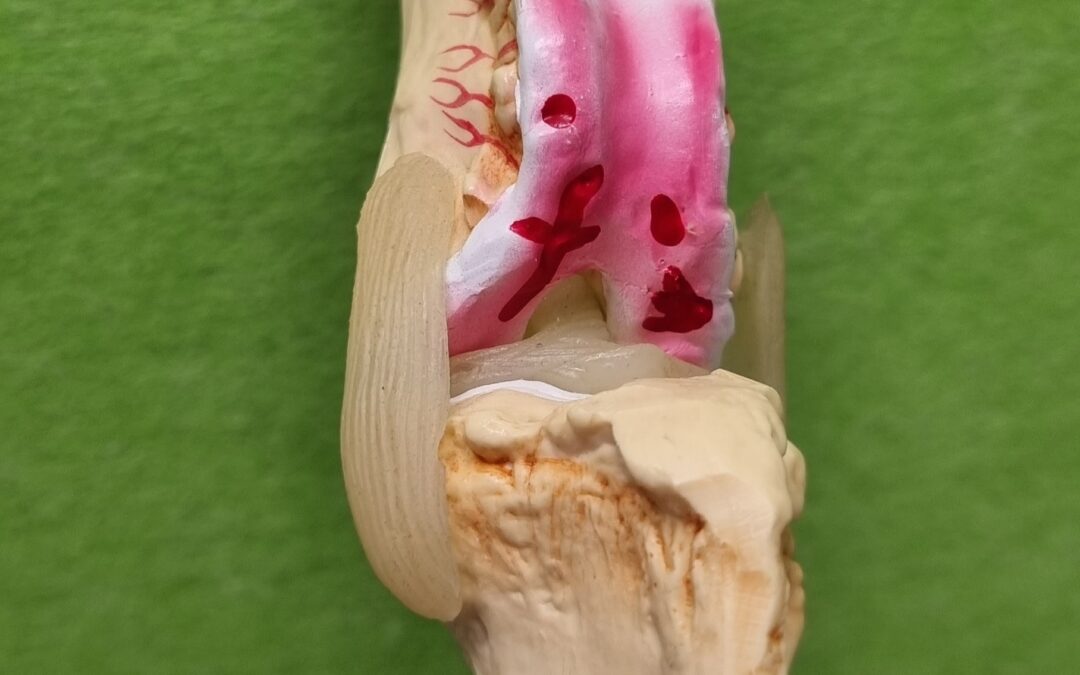Cruciate ligament injuries are one of the most common joint problems seen in dogs. Damage to the cruciate ligament is thought of more as a disease process that weakens the ligament, rather than a true traumatic injury. They can present in a number of ways from acute tears to mild chronic strains. Cruciate ligament injuries can be seen in many breeds, both small and large, and can effect dogs of any age from 1 year old up to those in their teens.
The Anterior Cruciate Ligament (ACL) is an important structure within the stifle (knee) joint. Its purpose is to stabilize the stifle joint, preventing the tibia (shin bone) from thrusting forward relative to the femur (thigh bone). When damaged, the stifle can become unstable causing pain and weakness of the affected joint. The instability can then lead to damage to other internal structures such as the meniscal cartilage.
Unlike people, a dog’s ACL is placed under tension every time weight is placed on the leg, and does not need strenuous activity to cause damage. This is because the tibial plateau, or base of the knee joint is sloped at a much steeper angle, compared to people who have a relatively flat plateau. This is similar to a trolley placed on a hill, with the ACL (like a piece of rope), stopping that trolley from sliding down the hill. The steeper the slope the more strain on the ligament, and also the heavier the dog the more load placed on the ligament.
In the majority of effected pets, ACL injuries are understood to be a degenerative disease process, leading to progressive weakness and partial damage, which finally results in a full tear. Generally by the time an ACL injury is diagnosed there is evidence of degenerative joint disease (DJD) and, in many cases, osteoarthritic changes visible on an X-ray.
It is also alarming that over 50% of pets who injure one leg will injure the opposite leg within 12-17mths. Many think it is because of the additional pressure placed on the opposite leg, but in actual fact it is because both ligaments are designed equal, and have the same weakness.
In some breeds there it is also suspected that there may be an immune mediated disease process, where the body’s own immune defense system attacks the ligaments thereby weakening it.

PARTIAL ACL INJURIES AND CHRONIC CHANGES
In these cases a pet may have signs including
• A slight limp which seems to last a short while and then resolve.
• Signs of lameness that is more noticeable after play and rest, with stiffness rising from a resting position.
• Slowing on walks, or hesitation jumping, which is noticeable over a short period of time
• Recurring lameness which can become more noticeable and get worse over several months
• As the damage progresses a persistent limp may be present but may not stop normal activity.
On Examination we might expect to find
• A slight limp
• Swelling and or Thickening of the affected joint
• Slight weight shift off the affected leg
• Sitting with the affected leg turned out to the side
• Muscle wastage of the affected leg
• Pain on hyperextension of the affected joint
• In more severe cases instability of the affected leg may be present
• Reduced range of movement and mobility of the affected stifle.
COMPLETE ACL TEARS AND ACUTE INJURIES
Most acute injuries result in complete ACL tears. A complete ACL tear will lead to severe instability of the knee, which causes more damage to cartilage and internal structures. This obviously leads to more pain swelling and reduced ability to place weight on the leg.
Acute: Occurs when a perfectly healthy ACL suddenly tears during play or activity.
This is more commonly seen in fit active breeds of dogs, and is similar to human sports AFL and netball where players can hyperextend the knee joint and snap their ACL.
Acute-on-Chronic: Occurs when a partially damaged ACL, suddenly tears fully. Other chronic signs described above may have already been noted, diagnosed, or present upon examination. Some acute-on-chronic cases can also occur as a result of meniscal cartilage tears.
Signs you may see:
• Sudden onset of severe lameness, where most pets may hold the leg up off the ground.
• Sometimes owners may hear a yelp whilst their pet is running or playing and then see them limping badly afterwards
On Examination we might expect to find
• A severe limp and many pets may be unable to place any weight on the leg.
• Swelling of the affected joint
• Pain on hyperextension of the affected joint
• Instability of the affected leg may be present, but may be hard to fully assess if too painful
DIAGNOSIS:
Diagnosing a cruciate ligament injury is twofold. Firstly a detailed history of how and when the injury occurred, and a thorough physical examination, which includes gait analysis.
On physical examination we look for several signs including:
- Swelling/inflammation/thickening of the knee joint
- Signs of Pain and reluctance to bear weight on the leg
- Reduced range of movement of the knee on physical examination
- Laxity or instability of the knee – diagnosed by a specific test known as a “drawer test”. In some dogs this test may be painful and sedation may be required to fully assess the extent of the instability.
- Pain particularly upon extension of the knee joint.Some pets may be too tense and painful for a full physical examination. We may suspect an ACL injury and provide adequate pain relief and antinflammatory medication and then reassess the degree of the injury.
Further assessment under sedation may also be required as this can help us determine the extent of the damage, we will also take an X-ray to look for signs of chronic changes including DJD and Osteoarthritis. The X-rays also help to rule out any other orthopaedic or bone conditions.
A careful history, clinical signs, physical examination, and X-rays will help determine the most suitable treatment plan for the best long term prognosis.
TREATMENT
Treating an ACL injury has to take into consideration both short term and long term outcomes. Unfortunately given the nature of these injuries any level of damage to the ACL can lead to a degree of DJD and Osteoarthritis, which tends to slowly get worse with time.
Short Term Goals
• Pain management
• Reduce Inflammation
• Surgical stabilizationLong Term Goals
• Improved mobility
• Reduced ongoing DJD and arthritis
• Maintain muscle
MEDICAL AND CONSERVATIVE MANAGEMENT
Mild strains and some chronic cases can be treated conservatively with
• Rest and controlled activity on lead
• A course of anti-inflammatory medication and Pain relief
• A course of Synovan which is an injection that helps healing, improves lubrication and reduces ongoing damage.
• Beransa – which is one of the newest treatments in joint pain management
SURGICAL STABILIZATION
For more severe cases where an acute tear has occurred or a chronic ACL that is getting worse and may have progressed to a full tear, surgery will be necessary to provide the best possible outcome. The aim of surgery will be to clean out the damage, and stabilize the joint which will reduce further damage. (More details on surgery will be provided if required)




